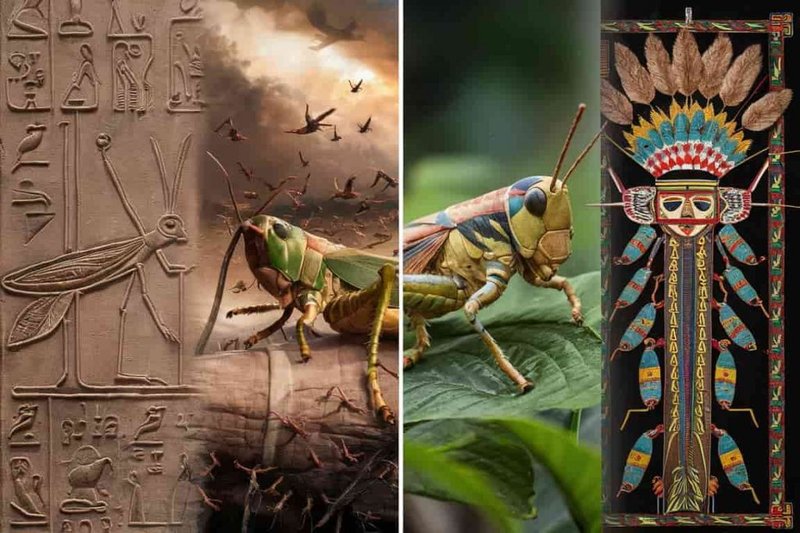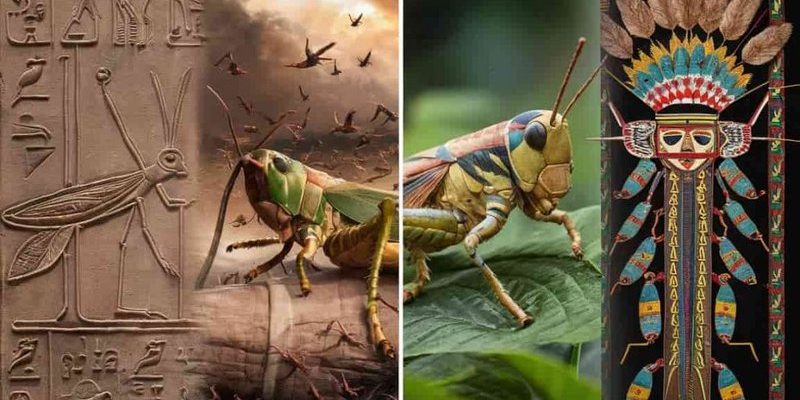
Think of locusts like nature’s reminders of resilience and adaptation. They can appear suddenly, sometimes in swarms so vast they turn day into night. While they can symbolize devastation, they also represent survival and the cyclical nature of life. This duality is what makes the cultural symbolism of the locust so rich and layered.
In this blog, we’ll explore the many facets of locust symbolism—from ancient texts to modern interpretations. Whether you’re curious about their role in different cultures or how they’ve inspired art and literature, you’re in the right place. Let’s dig deeper!
Locusts in Ancient Texts
Locusts have a long history in religious texts, particularly in the Bible. In the Book of Exodus, locusts are one of the ten plagues sent to Egypt, demonstrating the power of divine intervention. Here, they symbolize both punishment and the strength of faith. The devastation they cause serves as a warning about straying from righteous paths.
In other cultures, notably in Chinese mythology, locusts are viewed differently. They are often seen as symbols of prosperity and abundance. Ancient agricultural practices revered these insects, believing they brought fertility to the land. In this sense, locusts become a representation of the cycle of life—showing that destruction can also lead to new growth.
The way locusts are portrayed in literature also reflects these dual meanings. From ancient epics to modern novels, their presence often conveys a larger message about humanity’s relationship with nature. Have you ever noticed how nature sometimes mirrors our best and worst moments? Locusts embody this notion perfectly.
Symbolism in Different Cultures
As we move across the globe, the perspective on locusts shifts. In some African cultures, locusts are considered a delicacy. In fact, they are often harvested as a protein source, showcasing the theme of survival amidst scarcity. This practicality highlights how cultures adapt to their environments, turning potential threats into valuable resources.
In contrast, in many Western cultures, locusts are often linked to catastrophe. When swarms invade agricultural lands, they symbolize loss and desperation. This association might stem from historical famines where locusts played a significant role in crop failure. Thus, they have emerged as a cautionary symbol—reminding communities of the fragility of sustenance.
What’s fascinating is how symbolic meanings can evolve. While once merely pests, locusts can now signify resilience when communities come together to combat agricultural threats. Does this duality resonate with you? Seeing a creature from both sides can enrich our understanding of life’s complexities.
Locusts in Art and Literature
Locusts have inspired countless artists and writers over the years. For some, they represent chaos and destruction, while others see them as symbols of renewal. In visual art, they might appear in vivid colors, creating striking contrasts against barren landscapes. This imagery can evoke feelings of desolation, but also hope, as the cycle continues.
In literature, locusts often serve as metaphors for societal issues. Think of books that use nature to reflect human emotions. When a locust swarm decimates a farmer’s crops, it can imply a deeper commentary on poverty, struggle, or environmental disregard. The power of symbolism captivates audiences, encouraging them to think critically about the world around them.
Have you come across poems or stories featuring locusts? They often carry powerful messages that linger long after you’ve finished reading. Their ability to provoke thought mirrors the complex existence of these insects in our lives.
Locust Swarms and Their Environmental Impact
Locust swarms can be awe-inspiring but also devastating. When conditions are right—warm weather, abundant food—these insects can multiply at alarming rates. A single swarm can cover hundreds of square miles and consume crops in mere hours. This aspect elevates their symbolism as agents of destruction.
However, environmental scientists also study locusts to understand their behavior better. Their swarming phenomenon can indicate larger ecological shifts. You might be wondering, how do these swarms relate to other environmental changes? Well, they can disrupt ecosystems, but they also serve as reminders of nature’s power and adaptability.
In light of climate change, there’s an increasing interest in how locust patterns might shift. Understanding these dynamics can help societies prepare for potential agricultural challenges. Sometimes, it’s the smallest creatures that can teach us the biggest lessons about living in harmony with our environment.
Modern Interpretations of Locust Symbolism
In today’s world, locust symbolism has evolved further. As we face global challenges like climate change and food insecurity, locusts have come to symbolize resilience and adaptability. They remind us of the need to innovate and find solutions, especially in agriculture.
Additionally, in popular culture, locusts can be found in movies and songs, often representing chaos or transformation. These interpretations reflect society’s fears and hopes. For instance, a film featuring a locust swarm might explore themes of survival, illustrating the struggle of communities facing adversity.
This blend of fear and fascination keeps the cultural symbolism of locusts alive. They encourage us to confront our anxieties while also inspiring hope for renewal. Isn’t it interesting how a small insect can embody such vast concepts?
The Future of Locusts in Culture
Looking ahead, locusts will likely continue to hold significant meaning in various cultures. As our relationship with the environment evolves, so will the stories we tell about these insects. They may increasingly symbolize not just destruction but also the need for sustainability and responsible farming practices.
Moreover, as global populations grow, the discussion about food sources will surface more prominently. Locusts may be viewed as potential solutions rather than mere pests. Some researchers advocate for their consumption as an alternative protein source. This shift in perception could redefine locust symbolism in the coming years.
In this light, locusts remind us that change is constant. They symbolize the delicate balance of nature and humanity’s ongoing quest for harmony. As we navigate these complexities, the stories we tell about locusts will serve as guiding narratives for future generations.
Wrapping Up
The cultural symbolism of locusts is a rich tapestry woven through history, art, and environmental significance. These insects embody dualities of destruction and renewal, challenging us to reflect on our relationship with nature. Whether seen as pests or resources, locusts remind us of the complexities of life—the cycles of growth and decay we all experience.
So, the next time you hear the hum of locusts in the summer air, take a moment to think about what they represent. From ancient texts to modern interpretations, they’ve captivated our imaginations for centuries. In understanding their symbolism, we gain insights into our own stories and the world around us.

